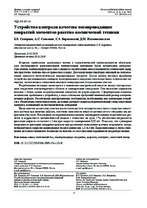| dc.contributor.author | Скворцов, Б. В. | |
| dc.contributor.author | Самсонов, А. С. | |
| dc.contributor.author | Борминский, С. А. | |
| dc.contributor.author | Живоносновская, Д. М. | |
| dc.coverage.spatial | Минск | ru |
| dc.date.accessioned | 2019-03-15T12:27:31Z | |
| dc.date.available | 2019-03-15T12:27:31Z | |
| dc.date.issued | 2019 | |
| dc.identifier.citation | Устройство контроля качества токопроводящих покрытий элементов ракетно-космической техники = Device for Conductive Coatings Quality Control of Rocket and Space Technique Elements / Б. В. Скворцов [и др.] // Приборы и методы измерений : научно-технический журнал. – 2019. – Т. 10, № 1. – С. 23-31. | ru |
| dc.identifier.uri | https://rep.bntu.by/handle/data/50722 | |
| dc.description.abstract | Широкое применение криогенных топлив в аэрокосмической промышленности обуславливает необходимость дополнительной теплоизоляции топливных баков летательных аппаратов. При этом на теплоизолирующем слое в процессе эксплуатации может возникнуть статический заряд, что при утечке топлива может привести к взрыву. Для исключения подобных ситуаций на теплоизоляцию наносится антистатическое токопроводящее покрытие. Целью работы являлась разработка устройства дистанционного контроля токопроводящего покрытия топливных баков летательных аппаратов, позволяющего оперативно находить и маркировать поврежденные участки.
Разработанная методика заключается в изменении электрической емкости между токопроводящим покрытием контролируемого объекта и сканирующим электродом. Она позволяет определять опасные с точки зрения искрообразования замкнутые по форме дефекты. Сформированы основные технические требования к устройству, а также обозначен требуемый минимальный размер контролируемого дефекта. Рассмотрены конструктивные особенности, необходимые для реализации устройства. Разработана структурная схема, на основе которой создан экспериментальный стенд емкостного контроля, основанный на мостовом методе измерений. Представлены результаты конечно-разностного расчета электрического поля в структуре емкостного датчика при наличии дефекта, получена зависимость емкости датчика от его смещения над дефектным участком. Полученные экспериментальные данные подтвердили данные теоретических расчетов и корректность математической модели с точностью не хуже 5 %, абсолютная погрешность фиксации дефекта составляет ± 2 мм при скорости сканирования 0,02 м/с. Показано, что суммарная погрешность фиксации координат дефекта при различных положениях датчика воздушного зазора,
температуры и скорости сканирования лежит в диапазоне 1,5–6,5 мм. Представленные в статье материалы позволяют повысить безопасность полетов за счет снижения вероятности искрообразования. | ru |
| dc.language.iso | ru | ru |
| dc.publisher | БНТУ | ru |
| dc.title | Устройство контроля качества токопроводящих покрытий элементов ракетно-космической техники | ru |
| dc.title.alternative | Device for Conductive Coatings Quality Control of Rocket and Space Technique Elements | ru |
| dc.type | Article | ru |
| dc.identifier.doi | 10.21122/2220-9506-2019-10-1-23-31 | |
| local.description.annotation | The widespread use of cryogenic fuels in the aerospace industry necessitates additional thermal insulation of aircraft fuel tanks. At the same time a static charge may occur on the heat insulating layer during operation which can lead to an explosion if fuel leaks. To avoid such situations an antistatic conductive coating is applied to the insulation. The aim of the study is to develop a device for remote control of conductive coatings of aircraft fuel tanks which allows to quick find and mark damaged areas. The developed method consists in changing the electrical capacitance between the conductive coating of the controlled object and the scanning electrode allowing to identify hazardous in terms of sparking closed
shape defects. The basic technical requirements for the device were formed and the required minimum size of the monitored defect were indicated. The design features necessary for the implementation of the device were considered. A block diagram were developed on the basis of which an experimental bench for capacitive control were created which were is based on the bridge measurement method. The article presents the results of the finite-difference calculation of the electric field in the structure of a capacitive sensor in the presence of a defect, the dependence of the capacitance of the sensor on its displacement over the defective area was also obtained. As the result of experimental studies the experimental data obtained confirmed the theoretical calculations and the correctness of the mathematical model with an
accuracy of no worse than 5 %, the absolute error of fixing the defect ± 2 mm at a scanning speed of 0,02 m/s. Was shown that the total error of fixing the coordinates of the defect at different positions of the air gap sensor, temperature and scanning speed lies in the range of 1,5–6,5 mm. The materials presented in the article make it possible to increase flight safety by reducing the likelihood of sparking. | ru |

